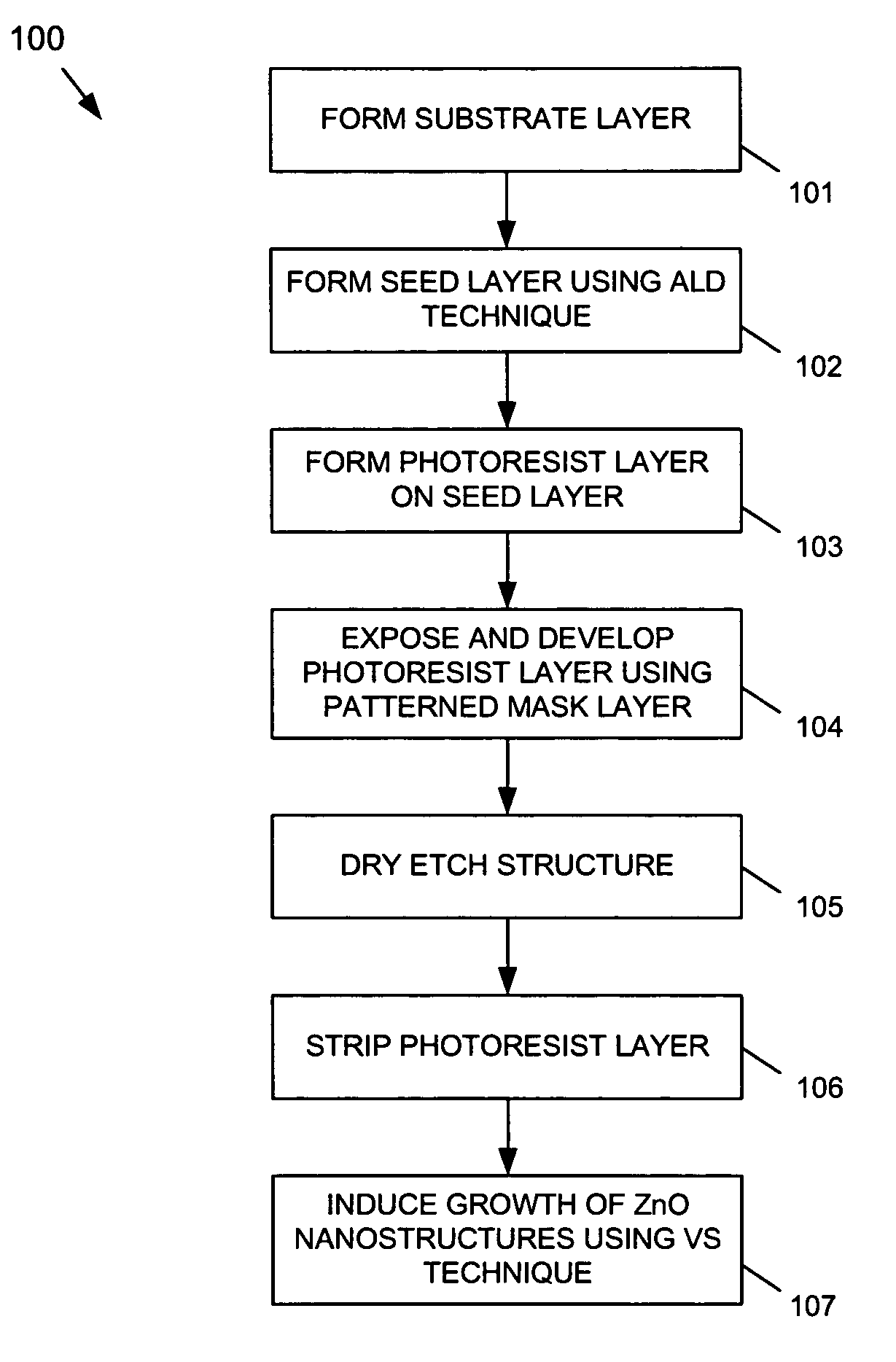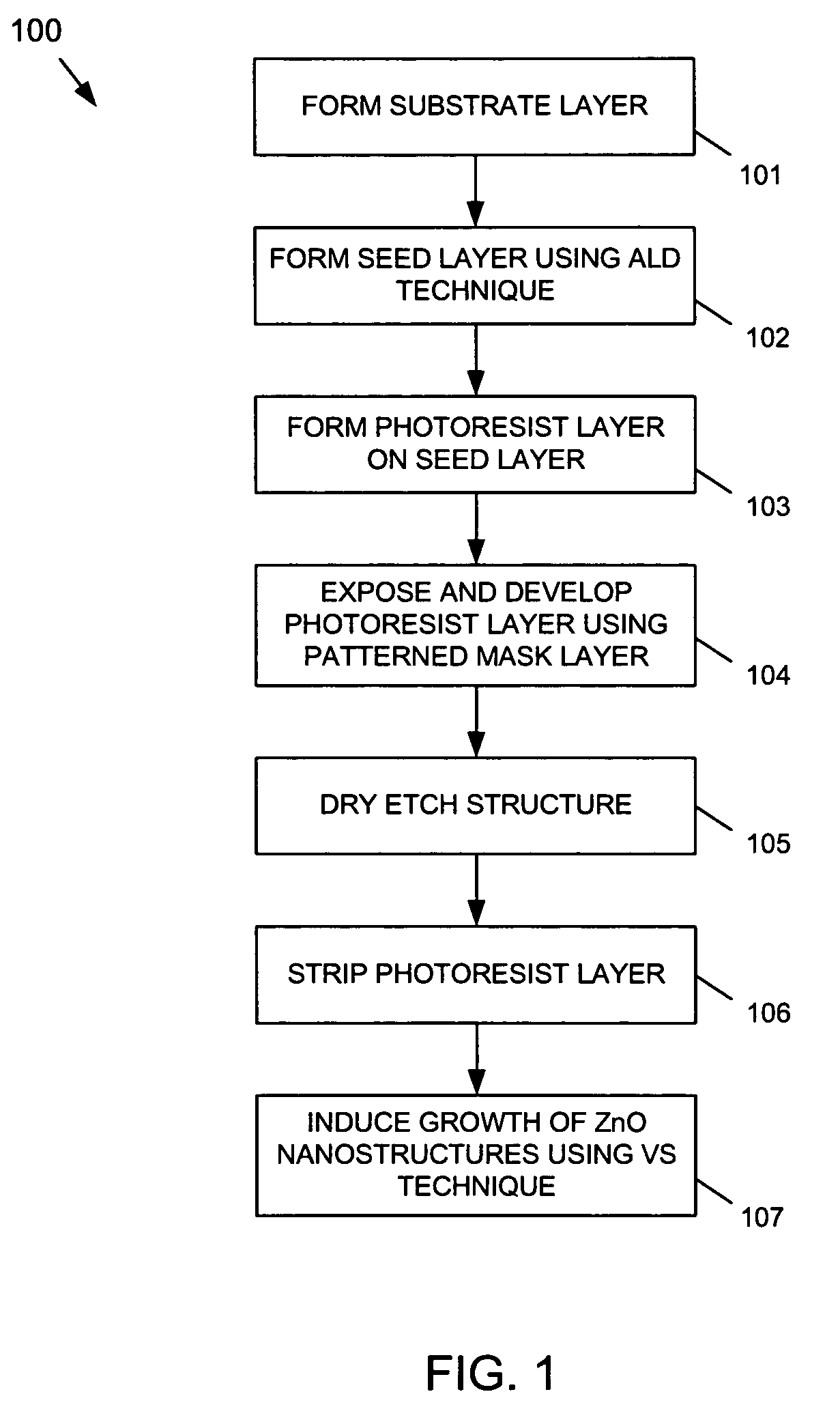Selective growth of ZnO nanostructure using a patterned ALD ZnO seed layer
a technology of zno nanostructure and seed layer, which is applied in the direction of single crystal growth, polycrystalline material growth, chemistry apparatus and processes, etc., can solve the problems of difficult subtractive patterning, difficult to etch metals used as catalysts for nanostructure growth, and inability to scatter particles onto substrates in ultra-clean environments used for microelectronic fabrication
- Summary
- Abstract
- Description
- Claims
- Application Information
AI Technical Summary
Benefits of technology
Problems solved by technology
Method used
Image
Examples
exemplary embodiment 100
[0018]FIG. 1 depicts a flowchart for a first exemplary embodiment 100 of a technique for selectively forming ZnO nanostructures according to the present invention. FIGS. 2A-2D depict a sequence of cross-sectional views of a substrate and ZnO nanostructures that are formed by the first exemplary embodiment of a technique for selectively forming ZnO nanostructures according to the present invention. At step 101 in FIG. 1, a clean Si 100, or Si 111 starting wafer is used as a substrate layer 201 (FIG. 2A). At step 102, a thin seed layer 202 of polycrystalline ZnO is deposited on the surface of substrate layer 201 using Atomic Layer Deposition (ALD) (FIG. 2A). For ALD, precursors are pulsed alternately into the deposition chamber and are separated by purges. Reactions take place on the substrate surface and are self-limiting. Film thickness is controlled by the number of precursor pulse / purge cycles. The self-limiting nature of the process allows for uniformity and excellent conformalit...
exemplary embodiment 300
[0023]FIG. 3 depicts a flowchart for a second exemplary embodiment 300 of a technique for selectively forming ZnO nanostructures according to the present invention. FIGS. 4A and 4B depict a sequence of cross-sectional views of a substrate and ZnO nanostructures that are formed by the second exemplary embodiment of a technique for selectively forming ZnO nanostructures according to the present invention. At step 301 in FIG. 3, a clean Si 100 or Si 111 starting wafer is used as a substrate layer 401 (FIG. 4A). At step 302, a thin seed layer 402 of polycrystalline ZnO is deposited on the surface of substrate layer 401 using a spin-on technique (FIG. 4A). In one exemplary embodiment, layer 402 is formed by a Metal Organic Deposition (MOD) technique using zinc acetate dehydrate in 2-methoxyethanol and ethanolamine to form MOD ZnO that is about 80 nm thick. Any thickness of MOD ZnO for seed layer 402 could be used. Alternatively, ZnO layer 402 could be deposited using other methods, such ...
PUM
| Property | Measurement | Unit |
|---|---|---|
| thick | aaaaa | aaaaa |
| temperature | aaaaa | aaaaa |
| temperature | aaaaa | aaaaa |
Abstract
Description
Claims
Application Information
 Login to View More
Login to View More - R&D
- Intellectual Property
- Life Sciences
- Materials
- Tech Scout
- Unparalleled Data Quality
- Higher Quality Content
- 60% Fewer Hallucinations
Browse by: Latest US Patents, China's latest patents, Technical Efficacy Thesaurus, Application Domain, Technology Topic, Popular Technical Reports.
© 2025 PatSnap. All rights reserved.Legal|Privacy policy|Modern Slavery Act Transparency Statement|Sitemap|About US| Contact US: help@patsnap.com



